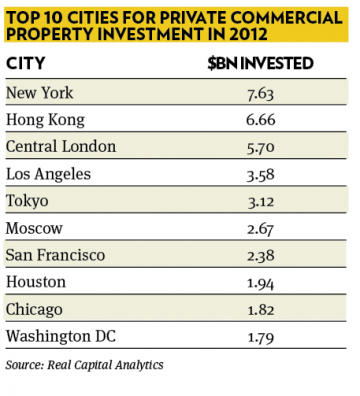Sky-high prices for prime property widen horizons

Rhian Horgan, JP Morgan Private Bank
Demand for prime property has driven up prices in gateway cities. Investors have responded by looking at secondary properties in these markets, while also considering less glamorous locations
Over the past few years, global search for income and desire for wealth preservation have driven large capital inflows into prime properties in gateway cities, pushing prices up to peak levels.
But are valuations still sustainable? Or is it time for investors to move up the yield curve?
“There is this incredible demand for real estate but primarily in gateway cities, even if pricing in trophy properties is back to pretty much peak value,” confirms Dan O'Donnell, Citi Private Bank’s global head of real estate and private equity.
The bond-like characteristics of this asset class greatly appeal to yield-starved investors, states Mr O’Donnell, as traditionally safe government bonds, such as US Treasuries, generate very low or even negative real returns. Clients’ expectations for capital appreciation and overall returns are much more measured.
While many cities are benefiting from the long-term urbanisation trend, only New York and London draw interest from all over the world, he says, which leads to a floor on values.
Citi Private Bank recently partnered with real estate developers in financing the construction of what will be the tallest condo tower in New York City, once finished in 2015. The former Drake Hotel site will eventually be home to 432 Park Avenue, all 1,395 feet of it. This real estate co-investment opportunity was offered with a minimum ticket size of $1m (€766m) to Citi’s wealthy clients around the world.
“Foreign investors are driving pricing in trophy real estate in New York City, not the financial industry. This allows us to support those valuations ranging from $5,000 and $10,000 per square foot,” states Mr O’Donnell.
Similarly in London, massive overseas demand is forcing prices up at fast rates, but with prime yields of about 5 per cent, London property still provides good yield if compared to bonds, says Dominic Wright, CEO at property investment specialist Riverside Capital.
The appeal of London real estate to overseas capital will remain strong this year. In 2012 investment volumes into London were £14.4bn (€16.8bn), an increase of 50 per cent over 2011. Around 71 per cent of this investment came from overseas compared to a long-run average of 53 per cent, according to Riverside Capital.
Strong demand is coming from Asian investors, in particular sovereign wealth funds, which seek income as well as diversification from their high growth and volatile markets.
Demand is driving yields down in London, although rental values remained stable over the past two years. With expectations of an improving economy, Mr Wright is “very bullish” on rental growth for the “right properties”, particularly in the West End, where supply is generally tight due to strict planning laws. In the City too, there are signs that with construction activity falling, rents are starting to pick up, driven by growing sectors such as insurance and technology.
“Rents are where you need to be careful in London. Properties need to have the right fundamentals and two buildings next to each other may have completely different values,” says Mr Wright.
Global portfolios
In an uncertain economic environment, large investors are increasingly building up global portfolios of prime locations in liquid markets, to mitigate their risk and diversify their exposure, says Robert Stassen, head of Emea Capital Markets Research at Jones Lang LaSalle.
Another key trend is that many investors are now starting to look to secondary properties, whose prices in last few years have been overly punished by the bi-polar, black and white market, divided between secondary/risky assets and safe/prime properties. “We are starting to see a more realistic view on valuations in some of the secondary markets, and we think the black, risky market will split into a ‘grey market’, more risky than the pure prime, which will start to recover,” he says.
This outlook is supported by the observation that today many buyers of prime properties aim at preserving their wealth, have long-term horizons and do not use as much leverage as in the boom and bust of the property market in 2007-2008. Also, there is not as much debt in the system. This contributes to stabilise the market and reduces the chances of a real estate bubble, says Mr Stassen.
“Trophy and core assets are either fully priced or at fair value, while opportunistic real estate looks mispriced,” comments Rhian Horgan, international head of alternative investment at JP Morgan Private Bank.
Wealthy families with very long-term investment horizons, interested in an inflation hedge in their portfolios, may still find trophy assets and some of the core assets attractive. But those looking at this asset class from an investment perspective are focusing on the value-add and opportunistic real estate, which involves some sort of operational turnaround or restructuring opportunity, she says. This segment is expected to generate around 15 per cent return, driven largely by price appreciation rather than income stream.
Pre-crisis, the yield gap between prime and secondary markets in the UK was about 1.5-2 per cent. Today, it is more than 5 per cent, the widest it has been in the last 15 years.
Generally, while trophy assets are trading at their 2008 levels, many distressed assets are trading at 30 to 50 per cent discount to replacement cost, says Ms Horgan.
Over the last four years, the bank has been very active in buying distressed real estate in the US. That opportunity still remains, she says, as credit markets have not recovered yet, a lot of debt is coming to maturity – US commercial banks hold about $900bn worth of commercial real estate loans that will mature over the next five years – and banks are selling assets on their balance sheet. Lack of capital generates the opportunity for individuals to finance investments through a private equity, or debt, structure.
On a risk-adjusted basis, Europe also looks very attractive for buying distressed assets in real estate, and some of the “savvy capital” has started moving from the US into Europe.
Russell Platt, CEO at global investment management firm Forum Partners agrees it is time to begin to look at “secondary quality properties that are well located”. There may be a greater risk to the tenancy and shorter-term leases but in return for that risk, investors will receive between 3 and 5 per cent additional yield annually, plus greater capital appreciation potential, he states.
“Through capital expenditure or re-tenanting programmes, these types of properties could be made into newer prime assets and enjoy the benefit of that substantial yield spread,” says Mr Platt.
In addition to New York, it is worth looking at cities such as Atlanta, Chicago or Dallas. In Germany, Frankfurt, Munich or Berlin are beginning to see a pick-up in office occupancy, but it is still too early for more speculative locations such as Spain, he believes.
The first thing I do when I land in an airport is to look at the skyline. If I see a lot of construction cranes, that’s a warning signal
With prices driven by the forces of supply and demand, the biggest risk to real estate comes from overbuilding, says Mr Platt. “The first thing I do when I land in an airport is to look at the skyline. If I see a lot of construction cranes, that’s a warning signal.” But apart from few exceptions such as China, the Middle East or the city of London, overbuilding is not a huge danger for the industry right now, he says.
Another key factor to monitor is credit. If there is too much, like in 2006-2007, there tends to be too much development and speculation, which pushes prices up.
Little credit can also be bad for values. “Dangerously low supply of credit in Europe has kept a real ceiling on valuations outside the very most prime markets,” he says. However, the credit conditions in the world are better than they were in 2008-2009, which should be supporting of investment property values. “As we move towards 2015-2016, we may begin to see more aggressive credit activity, and that’s a warning signal,” states Mr Platt.
The increasing global competition makes the business far more complex today, as real estate managers must be very attuned to currency, global trade flows, as well as pricing and return expectations that disparate investors bring to the same investment opportunity. “Real estate still remains more art than science. But old dogs need to learn new tricks if they are to continue to survive and prosper in this industry,” he says.
According to The Wealth Report 2013 by Knight Frank, private investors are looking to increase exposure to recovery-play investments this year, as property in a rising economy can provide steady growth to balance against the volatility that equities experience.
The lesson from London, among the first cities to recover, is that investors may need to accept a small loss in order to secure the right asset before the turning point, rather than wait until the market is crowed with bidders.
Last year’s London’s Battersea Power station deal by a Malaysian consortium, which is planning to build an entire new district with homes, shops, leisure, facilities and offices, is a good example of how global investors are thinking, according to Peter MacColl, global head of capital markets at Knight Frank. The site was bought when the news on the UK economy was still gloomy. “Opportunities on this scale are rare, and the cycle timing looks ideal,” says Mr MacColl.
Real estate in portfolios
Among the ultra-high-net-worth and most sophisticated clients, the level of interest in individual property investments or co-investments, as opposed to broad based fund investments, has been on the rise, observes Citi’s Mr O’Donnell. “The most sophisticated clients really like to be able to have an extra layer of transparency into the project; they want to know what they are buying and how much it is going to cost, as opposed to giving money to a fund manager who will make that decision for them,” he says.
Also, they prefer the shorter duration of a smaller pool of assets – five to seven years, versus 12 years of larger pools – which make generation planning easier.
Excluding personal property, real estate from an investment perspective accounts for around 10 per cent of clients’ overall portfolio at JP Morgan Private Bank, explains Ms Horgan. Investments can vary from single assets to diversified pools such as co-mingled private equity funds, to also include securitised products and whole loans. “Today we still see more value in the private market than in the listed market, but listed securities do provide an element of liquidity, which needs to be factored into the analysis,” she says.
Bank Julius Baer holds a different view. “Considering their liquidity, tax efficiency, transaction costs and governance, Reits (real estate investment trusts) are our most preferred investment vehicle in real estate,” says Daniel Kerbach, global head of portfolio management at Julius Baer, overseeing SF27.6bn (€22.6bn) in discretionary portfolios’ assets.
Investors learned the hard way during the financial crisis that illiquidity can be a major problem for open ended or, worse, for private equity funds.
In discretionary portfolios at Julius Baer, allocation to Reits has slightly increased to the “low single digit” percentage since last year.
Although it has a small weight, real estate is important for its diversification and income generating characteristics, says Mr Kerbach. It is imperative to evaluate whether the security is trading at a discount or a premium to the net asset value of the real estate assets it invests in. If it is trading at a discount, there is room for capital appreciation too. The bank today finds value in Central and Northern European markets, including Germany, and North America.
Reits are significantly correlated with the stockmarket, but generate higher risk-adjusted returns than equities. According to empirical studies, in the US market from 1978 to 2012 Reits generated a higher sharpe ratio than equities.
Inefficiency equals opportunity
Bringing the perspective of a manager investing in frontier markets, Tom Holland, head of Asia at Cube Capital, is cautious about hot markets such as Singapore and Hong Kong, which he sees as “the quantitative easing bubbles in the world”. In both jurisdictions, the respective governments have put in place cooling measures to curb speculation.
The firm’s philosophy is to operate in inefficient but booming markets, such as Myanmar or Vietnam. The Philippines are also a core investment today, as the country enjoys one of the healthiest economy in Asia, based on an emerging, aspirational middle class, excellent demographics, booming service sectors in cities, driving urbanisation, and affordable financing.
“We are very aware of the cycles and when to enter a market,” says Mr Holland. “We are looking for liquidity dislocation at the early stages of a boom, and we aim at getting exposure to a shorter tenor, using the entire capital structure, such as debt structure and preferred return structures.”
The investment target is to generate 25 per cent internal rate of return, he says, explaining that in frontier markets it is crucial to carry out due strict diligence on property developers and align interest with the locals by co-investing with them.







